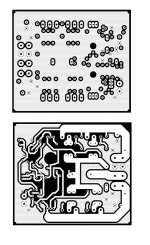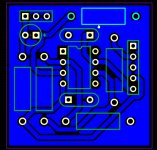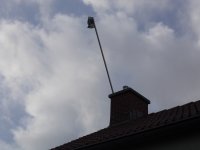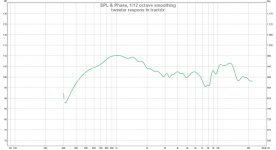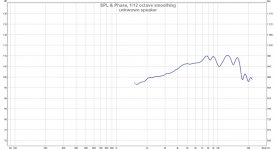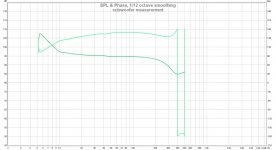I have ready now also the amplifier pcb who go drive the tapped horn, because a tapped horn doe not well with a analog crossover.
And the mic amp do well now (see pcb), it was the copper tube who did resonate with the mike in it, now it is decoupled in a aluminium housing.
I have made the Siegfried version for measure also high pressure.
So work, work, work pfff.
And the mic amp do well now (see pcb), it was the copper tube who did resonate with the mike in it, now it is decoupled in a aluminium housing.
I have made the Siegfried version for measure also high pressure.
So work, work, work pfff.
Attachments
What is the point of a big outdoor wifi transmitter? Is your neighbor using it to send wifi to another neighbor far away? Or trying to make wifi freely available to the whole neighborhood?
What is the point of a big outdoor wifi transmitter? Is your neighbor using it to send wifi to another neighbor far away? Or trying to make wifi freely available to the whole neighborhood?
His boss lives on place some km away and need internet, he is connected with the antenna, it has a reach of max 15 km and radiate 8 watts.
But now it is down, because the present storm has kill it, but still transmit, so the child 4 years sleeping there has now full power 5.8 gigahertz closer then 2 meters from the head.
I am sensitive for HF, so it is that I can not call with mobile phone for longer then 4 minutes, after that ringing and tickering occur in the ear, making me very dizzy.
Back to te horns, that radiate only sound who happenly I am not sensitive for
except when 120 + dB.
regards
I mistake by asking about the trynergy in the wrong thread elsewhere! So I paste here again the questions
I assume the 4 bass drivers help for the dynamic behavior as well ! But how do you wire them ?
It's off topic here and it's more a personal question : if I only use the Trynergy for the 10F, could the imaging soundstage be worse if I use a direct radiation driver of the same Sd (Active EQ and phase FIR) between 80 hZ and the 400 Hz XO ?
Btw what is the expansion of the tatrix please ? 90° ? more ?
I assume the 4 bass drivers help for the dynamic behavior as well ! But how do you wire them ?
It's off topic here and it's more a personal question : if I only use the Trynergy for the 10F, could the imaging soundstage be worse if I use a direct radiation driver of the same Sd (Active EQ and phase FIR) between 80 hZ and the 400 Hz XO ?
Btw what is the expansion of the tatrix please ? 90° ? more ?
I Have done a measurement with also tweeters and a unkwown spekaer from a pc box.
I ask myself, making a tractrix whith bigger mouth and speaker making a small tractrix inside will do the whole band with sensitivity.
But when do 108 dB and loose 12 dB is still 96 dB watt, not bad for a 3 inch.
PS wrong plots, unkwown is tweeter and tweeter is you now unkwown.
measurement is with no filters.
regards
I ask myself, making a tractrix whith bigger mouth and speaker making a small tractrix inside will do the whole band with sensitivity.
But when do 108 dB and loose 12 dB is still 96 dB watt, not bad for a 3 inch.
PS wrong plots, unkwown is tweeter and tweeter is you now unkwown.
measurement is with no filters.
regards
Attachments
Last edited:
I mistake by asking about the trynergy in the wrong thread elsewhere! So I paste here again the questions
I assume the 4 bass drivers help for the dynamic behavior as well ! But how do you wire them ?
It's off topic here and it's more a personal question : if I only use the Trynergy for the 10F, could the imaging soundstage be worse if I use a direct radiation driver of the same Sd (Active EQ and phase FIR) between 80 hZ and the 400 Hz XO ?
Btw what is the expansion of the tatrix please ? 90° ? more ?
I think imaging in tractrix is better since less wall reflections to mess things up. The angle is narrow - about 60deg even though it expands out smoothly to 180 at walls the main cone is defined early inside.
I think imaging in tractrix is better since less wall reflections to mess things up. The angle is narrow - about 60deg even though it expands out smoothly to 180 at walls the main cone is defined early inside.
Thanks.
Could be good for me as I have a balance problem in my room...I believe more direct field may solve the problem !
Hey XRK
Can you explain to me why there are not phase cancellation issues with the 4 drivers facing each other in the Trynergy?
Can you explain to me why there are not phase cancellation issues with the 4 drivers facing each other in the Trynergy?
It might be that the drivers are behind band pass ports and this provides a level of isolation via impedance mismatch. Mostly the radiation view factor coming into the port vs radiating outside is small. Think of cross sectional area of port vs area of mouth. Fraction is very small.
Not sure I totally get it yet though. Aren't the ports directly facing one another though? I visualize phase cancellation because of that.
I think this is how it works: the sound from one driver has to get out of the port, then go into the main horn volume where most of the energy will be directed out of the mouth, there is a small fraction of the sound from one driver that then must then go through the band pass port of the other driver and come into contact with the other driver cone for a half-wave cancellation. The area of the port is maybe 2% of the area of the mouth, so the feedback is only about that much thus the cancellation dip will be no more than that. If you are talking about cancellation out in free space, like comb interference when multiple tweeters are used, that is determined by the CTC distance between drivers and also requires open access for sound waves to make a complete circuit from cone-to-cone for the cancellation to occur. The drivers are in effect, acting as one large radiator the size of the horn mouth and "beaming" issues of directivity still apply. The output of the ports all inject pressure into the main horn volume and they combine coherently to form one large wave - the point source summation nature of the Synergy design. In the same way, you can ask why doesn't the sound from one side of a 15in woofer doesn't cancel with the other side? It does, and that causes narrow directivity at higher frequencies equal to the half-wave distance from one side to the other.
I don't have the speakers in front of me but I am guessing that the distance from one woofer cone on one side to the other cone on the other side with band pass ports and chambers is about 0.46m. That might cause a half-wave cancellation dip around 370Hz. That's for opposite sides. On the same side, they are the same wave so doesn't count. The dip might be about 2% to 5% at most. I do see some wiggles there but that is also affected by mouth diffractions and even some room effects.
There is a small dip that gets progressively deeper off-axis at 350Hz according to my measurement:
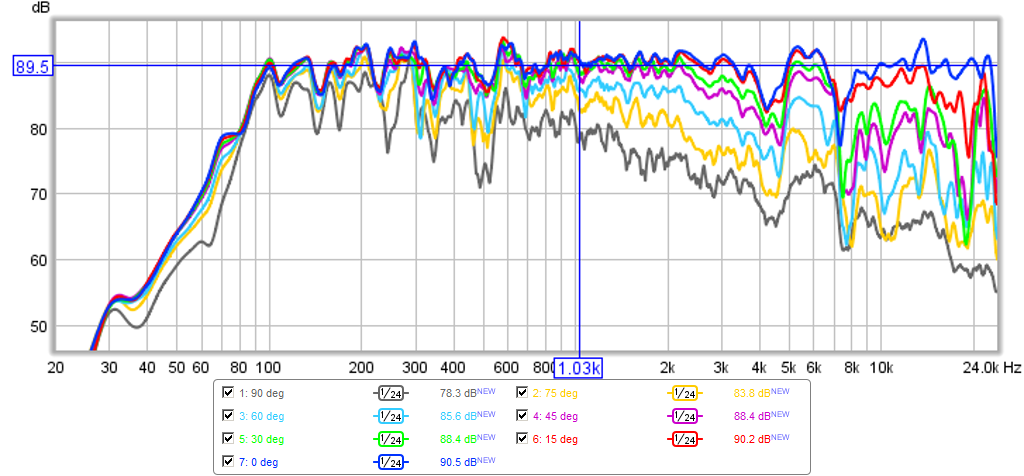
I don't have the speakers in front of me but I am guessing that the distance from one woofer cone on one side to the other cone on the other side with band pass ports and chambers is about 0.46m. That might cause a half-wave cancellation dip around 370Hz. That's for opposite sides. On the same side, they are the same wave so doesn't count. The dip might be about 2% to 5% at most. I do see some wiggles there but that is also affected by mouth diffractions and even some room effects.
There is a small dip that gets progressively deeper off-axis at 350Hz according to my measurement:

Last edited:
Nice measurements, I assume the dips below 500 Hz to be room (floor reflection?) behavior ?
And what about the 4 drivers per way ? 2 x // 8 ohms = 2 x 4 ohms ! so 4 ohms per 9 liters box (2 per way)
so one active amp for each 2 drivers/box ? So 3 amps per channel (with the 10F mi-treble) ? But only two chennel for DSP >FIR correction : mid-bass & mid-treble ?
Any advised link for a compact FLH able of 30/35 hZ to the 100 Hz needed for the Trynergy ? K-cabinet good & compact enough from 30/35 hZ to 100 Hz or bigger ?
Goal is 114 dB w/m efficienty but I don't know (trying to measure it now) the bass gain of my room yet ! Simple measurement gives me a 133 Hz Schroeder frequency... So I may need less but I will prefer a down eq to a linkwitz transform to keep the transcient behavior if a stronger 80 Hz-100 Hz for instance is needed (for the taste of the listener I am)...
Xrq, do the 2 x 9 liter cabinet could need a better solid structure (wood +foam) as you seem to suggest ? E.g. : thin 0.5" OBS or ply wood + foam ? (mostly to avoid vibration to be comunicated to the foam horn)
thanks for the inputs !
Hey : a poll around 3 drivers at the Apex of the Trynergy 😀 ?
- 10F (reccorded already)
- 88EX (2" but the 10F is already 20k Hz enable in the horn-at least I don't understand how a horn can extend the fundamental made below at 15 Hz to climb at 20 Hz : is it not the lower second harmonic which is measured at 20k Hz ?.... good as well because pleasant to the ears : a tube sound without tube 🙂 )
- 80F (because folk want always a paper 🙄... c'est casual !)
regards
I mean those drivers because for the rest of them, europeans and the rest of the world don't live near a Part-Express shop (little lucky guys 😎)
And what about the 4 drivers per way ? 2 x // 8 ohms = 2 x 4 ohms ! so 4 ohms per 9 liters box (2 per way)
so one active amp for each 2 drivers/box ? So 3 amps per channel (with the 10F mi-treble) ? But only two chennel for DSP >FIR correction : mid-bass & mid-treble ?
Any advised link for a compact FLH able of 30/35 hZ to the 100 Hz needed for the Trynergy ? K-cabinet good & compact enough from 30/35 hZ to 100 Hz or bigger ?
Goal is 114 dB w/m efficienty but I don't know (trying to measure it now) the bass gain of my room yet ! Simple measurement gives me a 133 Hz Schroeder frequency... So I may need less but I will prefer a down eq to a linkwitz transform to keep the transcient behavior if a stronger 80 Hz-100 Hz for instance is needed (for the taste of the listener I am)...
Xrq, do the 2 x 9 liter cabinet could need a better solid structure (wood +foam) as you seem to suggest ? E.g. : thin 0.5" OBS or ply wood + foam ? (mostly to avoid vibration to be comunicated to the foam horn)
thanks for the inputs !
Hey : a poll around 3 drivers at the Apex of the Trynergy 😀 ?
- 10F (reccorded already)
- 88EX (2" but the 10F is already 20k Hz enable in the horn-at least I don't understand how a horn can extend the fundamental made below at 15 Hz to climb at 20 Hz : is it not the lower second harmonic which is measured at 20k Hz ?.... good as well because pleasant to the ears : a tube sound without tube 🙂 )
- 80F (because folk want always a paper 🙄... c'est casual !)
regards
I mean those drivers because for the rest of them, europeans and the rest of the world don't live near a Part-Express shop (little lucky guys 😎)
Last edited:
Nice measurements, I assume the dips below 500 Hz to be room (floor reflection?) behavior ?
Yes room modes - go away upon gated measurement at 5ms.
And what about the 4 drivers per way ? 2 x // 8 ohms = 2 x 4 ohms ! so 4 ohms per 9 liters box (2 per way)
I went series parallel for 4ohm per 4 drivers and got 94dB this way and maybe 2dB gain from horn directionally for 96dB overall. 2 amps per Trynergy.
so one active amp for each 2 drivers/box ? So 3 amps per channel (with the 10F mi-treble) ? But only two chennel for DSP >FIR correction : mid-bass & mid-treble ?
Any advised link for a compact FLH able of 30/35 hZ to the 100 Hz needed for the Trynergy ? K-cabinet good & compact enough from 30/35 hZ to 100 Hz or bigger ?
Try a tapped horn - more compact. Look at the TH-18 thread in subwoofers. It has about the right sensitivity to keep up and is easy to build and provides a 38in tall bass to prop the Trynergy in top. Flip it upside down so mouth is up high and close to mouth of Trynergy. This box is about 100dB sensitive with typical 97dB 18in drivers and goes to 38Hz flat.
Goal is 114 dB w/m efficienty but I don't know (trying to measure it now) the bass gain of my room yet ! Simple measurement gives me a 133 Hz Schroeder frequency... So I may need less but I will prefer a down eq to a linkwitz transform to keep the transcient behavior if a stronger 80 Hz-100 Hz for instance is needed (for the taste of the listener I am)...
You need a huge impractical bass horn to get 114dB below 100Hz. The horns would be 500lbs and the size of two refrigerators. Look at Danley BC218 as an example.
Xrq, do the 2 x 9 liter cabinet could need a better solid structure (wood +foam) as you seem to suggest ? E.g. : thin 0.5" OBS or ply wood + foam ? (mostly to avoid vibration to be comunicated to the foam horn)
Yes, I have problems with vibrations on mine. Make sturdy out of at least half in plywood and line with foam or felt. Use sturdy screws to hold in place to main horn.
thanks for the inputs !
Hey : a poll around 3 drivers at the Apex of the Trynergy 😀 ?
- 10F (reccorded already)
- 88EX (2" but the 10F is already 20k Hz enable in the horn-at least I don't understand how a horn can extend the fundamental made below at 15 Hz to climb at 20 Hz : is it not the lower second harmonic which is measured at 20k Hz ?.... good as well because pleasant to the ears : a tube sound without tube 🙂 )
- 80F (because folk want always a paper 🙄... c'est casual !)
regards
I mean those drivers because for the rest of them, europeans and the rest of the world don't live near a Part-Express shop (little lucky guys 😎)
I am guessing that the distance from one woofer cone on one side to the other cone on the other side with band pass ports and chambers is about 0.46m. That might cause a half-wave cancellation dip around 370Hz. That's for opposite sides.
Mr. Danley has said that the distance btn the opposing drivers is ¼ wavelength of the highest freq to be reproduced by these drivers.
Ditto for the 'cone' apex to drivers distance
xrk971 I want to thank you for your contribution to this site.
You are a true diyer, a consistent hard worker and a give-away marvel.
God bless you 🙂
George
Last edited:
maybe i'm out to lunch hear but if you add a 1/2 octave multiple back to the prime frequency in this case 370 + 185=555 explains why the further off axis you go the cancellation increases in frequency.
1/4 oct = 462.2 and although the effect is less pronounced or my reading of the graph is wrong there's a V dip there.
I Have did a measurement of the TQWT sub, because it was not yet good damped, now it do well and has nice plot.
Not used for horn, but I have small box together with that, the big open baffles are gone now. So I can sell them when needed, but it has to work.
regards
Not used for horn, but I have small box together with that, the big open baffles are gone now. So I can sell them when needed, but it has to work.
regards
Attachments
- Home
- Loudspeakers
- Multi-Way
- Presenting the Trynergy - a full range tractrix synergy.
